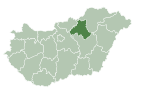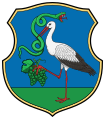Gyöngyös
Gyöngyös | |
|---|---|
Town | |
 Saint Bartholomew Church | |
| Coordinates: 47°47′07″N 19°55′32″E / 47.78528°N 19.92556°E | |
| Country | |
| County | Heves |
| District | Gyöngyös |
| First mentioned | 1299 |
| Government | |
| • Mayor | György Hiesz (MSZP) |
| Area | |
| • Total | 54.69 km2 (21.12 sq mi) |
| Population (2022) | |
| • Total | 27,957 |
| • Density | 510/km2 (1,300/sq mi) |
| Time zone | UTC+1 (CET) |
| • Summer (DST) | UTC+2 (CEST) |
| Postal code | 3200, 3221, 3232, 3233 |
| Area code | 37 |
| Website | www.gyongyos.hu |
Gyöngyös is a town in Heves County, Hungary, beside of the Gyöngyös creek, under the Mátra mountain ranges. As of 2022 census, it has a population of 27,957 (see Demographics). The town located 8.4 km from the M3 motorway and 80.8 km far from Budapest. Gyöngyös is terminus of the (Nr. 85) Vámosgyörk–Gyöngyös railway line and the main road 3 lead across the town. Gyöngyös have a train station and a stop on the standard gauge railway line and two narrow gauge railways also start from here to the mountains for tourist purposes.
History
It is the home of numerous food production plants, including milk production and sausage factories. It is also the home of many vineyards on the slopes of the Sárhegy. The Art-Nouveau and Baroque buildings around the main square were reconstructed after a disastrous fire started in the local hospital in 1917,[1] destroying a number of buildings housing important Jewish institutions and leaving in all around 8,000 homeless.[2] The meaning of the town's name is "Made of Pearls"; Croats from Hungary call this city Đunđuš (Serbo-Croatian pronunciation: [ˈdʑûndʑuʃ]). The 16/17th-century historian Miklós Istvánffy wrote that the name of the town comes from the Hungarian word for mistletoe (fagyöngy literally "wood-pearl"), which is abundant in the local woods. Gyöngyös was home to a large Jewish community before World War II. In 1942, anti-Jewish laws were adopted in the province, affecting the Jews of the town.[3] Following the occupation of Hungary by the German army in March 1944, 1800 Jews were locked in a ghetto. Some were saved by Hungarian Righteous Among the Nations personnel but most of them were deported to Auschwitz where they were murdered.[4] There are many monuments and places of interest in the town, such as the Orczy mansion, home of the Mátra Museum, Saint Bartholomew's Church (Saint Bartholomew Church, Gyöngyös, Hungary) in the center of town, and its Treasury.[citation needed]
Demographics
According the 2022 census, 88.3% of the population were of Hungarian ethnicity, 2.9% were Gypsies, 0.7% were Ukrainians, and 10.9% were did not wish to answer. The religious distribution was as follows: 34.7% Roman Catholic, 3.4% Calvinist, 14.2% non-denominational, and 43.9% did not wish to answer. The Gypsies and the Ruthenians have a local nationality government. 844 people live in Mátrafüred, 80 live in Mátraháza and 14 live in Kékestető other inner areas, furthermore 56 people live in 6 other outskirts. Mátrafüred (3232), Mátraháza (3233) and Kékestető (3221) have an postal code.[5]
Population by years:[6]
| Year | 1870 | 1880 | 1890 | 1900 | 1910 | 1920 | 1930 | 1941 |
|---|---|---|---|---|---|---|---|---|
| Population | 16,622 | 16,843 | 16,950 | 17,301 | 19,422 | 19,647 | 21,213 | 24,053 |
| Year | 1949 | 1960 | 1970 | 1980 | 1990 | 2001 | 2011 | 2022 |
| Population | 21,969 | 28,573 | 30,306 | 36,282 | 36,404 | 32,975 | 30,728 | 27,957 |
Politics
Mayors since 1990:
- 1990–1994: György Keresztes (KDNP)[7]
- 1994–2002: Gyula Szabó (MSZP, after 1998 supported by the SZDSZ too)[8][9]
- 2002–2010: György Hiesz (MSZP, until 2006 supported by the SZDSZ too)[10][11]
- 2010–2014: László Faragó (Fidesz–KDNP)[12]
- 2014–: György Hiesz (MSZP-DK,until 2019 supported by the Együtt, after 2019 supported by the Momentum too)[13][14]
Notable people
- Pál Vay (1735–1800), field marshal
- János Hám (1781–1857), Bishop of Szatmár
- Pál Bugát (1793–1865), doctor and linguistican
- Sándor Vachott (1818–1861), poet, brother of Imre Vahot
- Pál Almásy (1818–1882), politican
- Imre Vahot (1820–1879), writer, brother of Sándor Vachott
- József Zalár (1825–1914), poet, politican
- Károly Kamermayer (1829–1897), politican, educated in Gyöngyös
- Rudolf von Brudermann (1851–1941), general
- Soma Visontai (1854–1925), politican
- Gedeon Richter (1872–1944), pharmacist, grown up in Gyöngyös
- Béla Kerékjártó (1898–1946), mathematican
- Attila Szekrényessy (1913–1995), figure skater
- György Bálint (1919–2020), horticulturist
- István Tamási (1924–1995), horticulturist
- Balázs Balázs-Piri (1937–2014), grafican, caricaturist
- Margit Gréczi (1941–), painter
- László Polgár (1946–), chess teacher, psychologist, his three daughters are Zsuzsanna, Zsófia and Judit chess masters and grandmasters.
- Ferenc Debreczeni (1948–), musician
- Tamás Király (1952–2013), fashion designer
- Pál Molnár (1952–), journalist
- Gábor Fodor (1962–), politican, minister
- Gábor Kálomista (1964–), film producer
- József Balázs (1965–), politican
- Ferenc Bozók (1973–), poet
- Gabriella Csépe (1973–), swimmer
- Zsófia Lakatos (1975–), economist
- Gábor Vona (1978–), politican
- András Zelena (1984–), psychologist
- Péter Kiss (1986–2013), mountaineer
- Zsófia Kovács (1988–), triathlete
Twin towns – sister cities
 Lendava, Slovenia (2019)
Lendava, Slovenia (2019) Luohe, China (2019)
Luohe, China (2019) Manisa, Turkey (2012)
Manisa, Turkey (2012) Pieksämäki, Finland (2000)
Pieksämäki, Finland (2000) Ringsted, Denmark (1973)
Ringsted, Denmark (1973) Sanok, Poland (2016)
Sanok, Poland (2016) Shusha, Azerbaijan (2013)
Shusha, Azerbaijan (2013) Štip, North Macedonia (2002)
Štip, North Macedonia (2002) Târgu Secuiesc, Romania (1995)
Târgu Secuiesc, Romania (1995) Zeltweg, Austria (1993)
Zeltweg, Austria (1993)
Gallery
-
Aerial photograph of the water tower, built in 1927.
-
Orczy palace of Orczy family
-
Gyöngyös 1938
References
- ^ Charles Hebbert; Norm Longley; Dan Richardson (2002). Hungary (Rough Guide Travel Guides). Rough Guides Ltd. p. 323. ISBN 1-85828-917-3.
- ^ Adrian Phillips, Jo Scotchmer (2010). Bradt Travel Guides. Hungary. p. 222. ISBN 978-1-84162-285-9.
- ^ "Horváth Kálmán". The Righteous Among the Nations Database. Retrieved 18 December 2020.
- ^ "המכון הבין-לאומי לחקר השואה – יד ושם". www.yadvashem.org (in Hebrew).
- ^ "Gyöngyös". ksh.hu. Hungarian Central Statistical Office. Retrieved 12 July 2024.
- ^ "Population number, population density". Hungarian Central Statistical Office. Retrieved 22 February 2024.
- ^ "Vitázzon a testület, de megfelelő stílusban (Debate the board, but in an appropriate style)" (pdf) (in Hungarian). Heves County's Newspaper. Retrieved 12 July 2024.
- ^ "Gyöngyös settlement election results" (in Hungarian). National Election Office. Retrieved 12 July 2024.
- ^ "Gyöngyös settlement election results" (in Hungarian). National Election Office. Retrieved 12 July 2024.
- ^ "Gyöngyös settlement election results" (in Hungarian). National Election Office. Retrieved 12 July 2024.
- ^ "Gyöngyös settlement election results" (in Hungarian). National Election Office. Retrieved 12 July 2024.
- ^ "Gyöngyös settlement election results" (in Hungarian). National Election Office. Retrieved 12 July 2024.
- ^ "Gyöngyös settlement election results" (in Hungarian). National Election Office. Retrieved 12 July 2024.
- ^ "Gyöngyös settlement election results" (in Hungarian). National Election Office. Retrieved 12 July 2024.
- ^ "Gyöngyös testvérvárosai" (in Hungarian). Gyöngyös. Retrieved 21 September 2021.
External links
- Official website (in Hungarian and English).
- "Gyöngyös információs és hír enciklopédiája-Minden egy helyen! - Kezdőlap". gyongyos.info (in Hungarian). Archived from the original on 15 October 2007.








